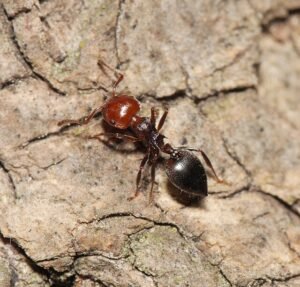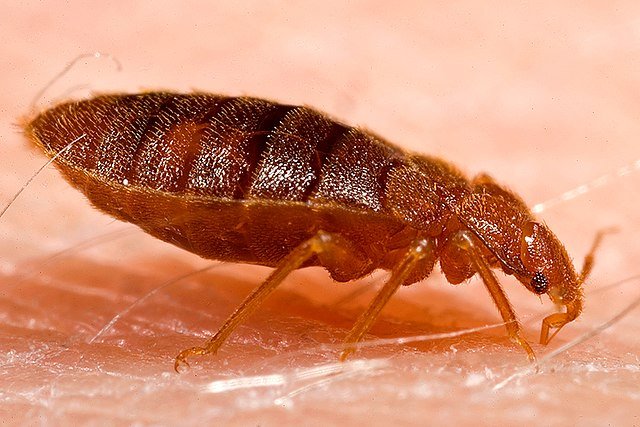Acrobat Ants (Crematogaster spp.): Behavior, Risks, and Control
 In the world of ants, few species are as visually distinctive as the acrobat ants (Crematogaster spp.). Their name comes from their unusual habit of raising their heart-shaped gaster (abdomen) above their thorax when disturbed, almost like a gymnast performing a backbend.
In the world of ants, few species are as visually distinctive as the acrobat ants (Crematogaster spp.). Their name comes from their unusual habit of raising their heart-shaped gaster (abdomen) above their thorax when disturbed, almost like a gymnast performing a backbend.
Although less famous than Odorous house ants (Tapinoma sessile) or Pavement ants (Tetramorium immigrans), acrobat ants are widespread across urban and rural landscapes. They are opportunistic nesters that exploit rotting wood, tree cavities, and sometimes voids within buildings. Because they frequently colonize damp or previously damaged structures, they are often mistaken for Carpenter ants (Camponotus spp.).
Understanding their identification, biology, and potential risks is essential not only for pest professionals but also for homeowners dealing with recurring infestations.
Identification
Key Morphological Traits
Size: 2.5–3 mm (workers).
Color: Light brown to dark brown or black.
Antennae: 11 segments, ending in a three-segmented club.
Thorax and gaster: The gaster is distinctly heart-shaped and can be raised over the body when threatened.
Odor: Unlike odorous house ants, acrobat ants do not release a pungent smell when crushed.
Behavior as an Identifier
The defensive posture—gaster raised high in an “acrobat” position—is their signature. In contrast, Ghost ants (Tapinoma melanocephalum), another common household pest, rely on their pale coloration and faint odor for recognition.
Biology and Ecology
Colony Structure
Colonies typically contain a single queen, though multiple-queen colonies can occur in established populations. Worker ants forage actively, usually in trails, and are highly responsive to food sources.
Feeding Habits
Acrobat ants are omnivorous. Their diet includes:
Honeydew produced by aphids and scale insects.
Live or dead insects.
Household sweets and proteins when indoors.
Nesting Preferences
Outdoors: tree cavities, beneath bark, rotting logs, or soil adjacent to roots.
Indoors: wall voids, damp wood, or insulation damaged by leaks.
Moisture plays a central role in nest selection. Colonies often exploit preexisting damage, such as termite galleries or carpenter ant tunnels.
Global Distribution
Acrobat ants occur worldwide, but the highest diversity is in tropical and subtropical regions. In North America, Crematogaster lineolata and Crematogaster cerasi are the most common species found near or inside human structures.
United States: Common in the eastern, southern, and midwestern regions.
Europe: Scattered populations, mainly in warmer areas.
Asia & Africa: Rich diversity, especially in tropical forests where acrobat ants act as important predators of other insects.
Risks and Damage
While acrobat ants are not primary wood destroyers like termites, they can still cause significant issues:
Structural damage – They hollow out softened wood, often spreading pre-existing damage.
Electrical issues – Documented cases show acrobat ants nesting in insulation and even chewing wires.
Food contamination – Foraging ants may contaminate stored products, though less aggressively than Fruit flies (Drosophila spp.) or Blow flies (Calliphoridae).
Health risks – They do not transmit diseases but can bite when disturbed, causing minor irritation.
Signs of Infestation
Detecting acrobat ants requires attention to subtle clues:
Foraging trails along foundations, windowsills, or electrical wires.
Discarded frass (fine wood shavings) near nesting areas.
Nests inside insulation or under floors in humid zones.
Raised gaster behavior when disturbed.
Compared with Pharaoh ants (Monomorium pharaonis), infestations are more localized but often linked to structural moisture problems.
Control Methods
1. Inspection and Monitoring
Locating the nest is crucial. Follow foraging trails back to wall voids or wood cavities. Moisture meters may help identify damp areas attractive to acrobat ants.
2. Sanitation
Reduce food access (seal sweets, proteins, and pet food).
Control honeydew-producing insects outdoors.
3. Exclusion
Seal cracks in foundations, window frames, and rooflines. Pay attention to areas where vegetation touches structures.
4. Chemical Control
Baits with slow-acting toxicants (protein or sugar-based depending on season).
Residual insecticides applied to entry points.
5. Non-chemical Control
Vacuuming trails.
Physical removal of infested wood or insulation.
Advanced Approaches
Modern pest management for acrobat ants includes more targeted strategies:
Moisture management: Fix leaks and improve ventilation.
Biological control: In natural ecosystems, predators like spiders and parasitoid wasps regulate acrobat ant populations.
Integrated Pest Management (IPM): Combining monitoring, sanitation, and selective chemical treatments for sustainable results.
In commercial spaces, IPM reduces chemical use and ensures compliance with regulations.
Cultural and Historical Context
Ants have long fascinated humans, appearing in mythology, folklore, and literature. While Pigeons (Columba livia) symbolize freedom and peace, ants often symbolize industriousness. Acrobat ants, with their dramatic defensive posture, add a theatrical dimension to the cultural perception of ants.
In some cultures, their unusual posture has been interpreted as a symbol of agility or balance, though no specific folklore centers exclusively on acrobat ants.
Frequently Asked Questions (FAQ)
Q1: How do I tell acrobat ants apart from carpenter ants?
Carpenter ants are larger (6–12 mm) and lack the heart-shaped abdomen raised in defense. Acrobat ants are smaller and prefer damp or damaged wood.
Q2: Are acrobat ants dangerous to humans?
They may bite when provoked, but the effects are minor irritation. They do not spread disease.
Q3: Why do acrobat ants nest in electrical equipment?
The warmth and void space provide shelter, while insulation resembles natural nesting substrates.
Q4: Can acrobat ants live alongside other ant species?
Yes, but competition for resources is strong. Colonies often displace smaller species such as odorous house ants.
Q5: Are they seasonal pests?
Infestations peak in warm months when foraging intensifies, though indoor colonies remain active year-round.
Q6: What is the best prevention method?
Moisture control and sealing structural gaps are the most reliable long-term measures.
Final Thoughts
Acrobat ants (Crematogaster spp.) may not be as notorious as termites or carpenter ants, but they can still cause considerable frustration for homeowners and property managers. Their ability to exploit pre-existing structural weaknesses—especially damp or damaged wood—makes them persistent intruders. Unlike Fruit flies (Drosophila spp.) or Blow flies (Calliphoridae) that thrive on food waste, acrobat ants focus on moisture and nesting opportunities.
For pest control professionals, understanding their distinctive biology and behavior allows for more precise management strategies. Prevention should always start with addressing water leaks, improving structural integrity, and eliminating accessible food sources. Chemical solutions may provide short-term relief, but sustainable success often comes from integrated pest management (IPM) approaches that blend monitoring, sanitation, and exclusion techniques.
Acrobat ants remind us of a simple truth: pest problems often signal deeper environmental issues. By controlling moisture and maintaining structural soundness, infestations can not only be reduced but also prevented long-term.
Disclaimer
This article is for informational purposes only. Pest control laws and approved chemicals vary by country. For best results and legal safety, we strongly recommend contacting a licensed pest control professional in your local area. Always make sure that the pest control technician is properly certified or licensed, depending on your country’s regulations. It’s important to confirm that they only use approved products and apply them exactly as instructed on the product label. In most places in Europe, UK, or USA, following label directions is not just best practice—it’s the law.
Author Bio
Nasos Iliopoulos, MSc Agronomist & Certified Pest Control Expert
Scientific Director – Advance Services (Athens, Greece)
Licensed Pest Control Business – Ministry of Rural Development & Food (GR)
References
Michigan state university – “Acrobat Ants.”
Wikipedia –Crematogaster

